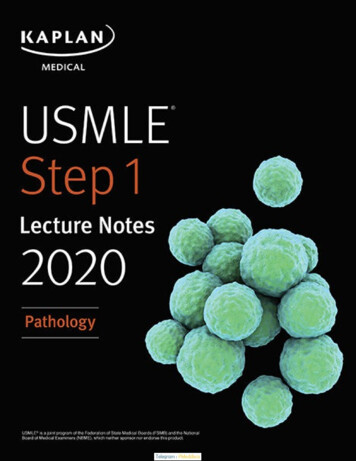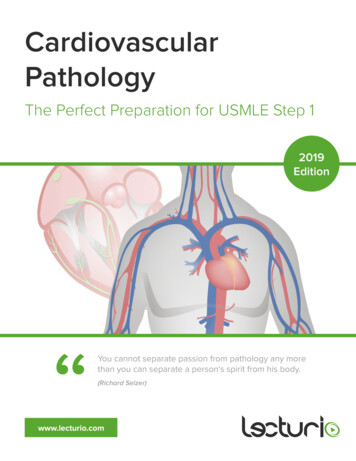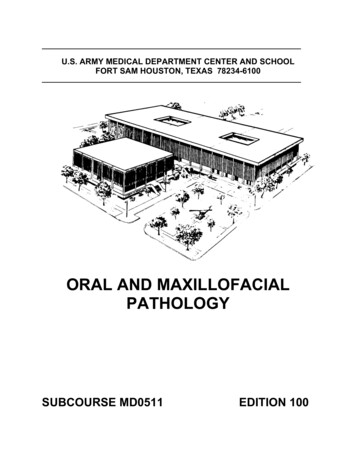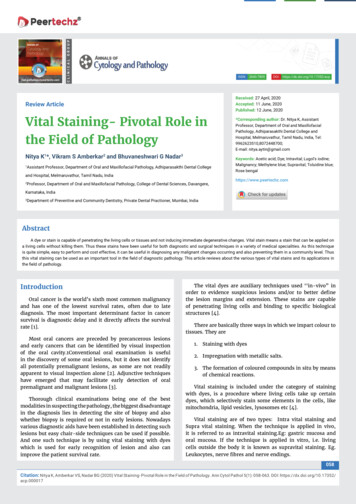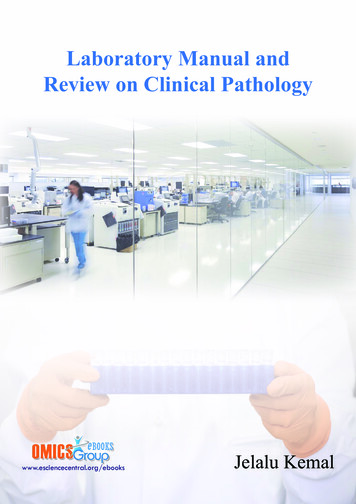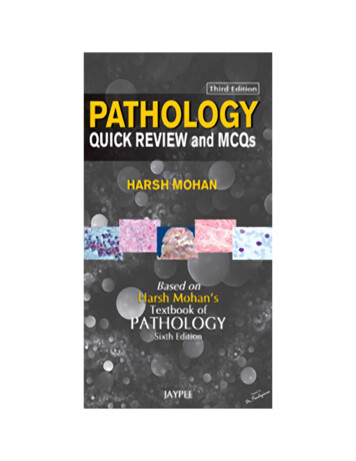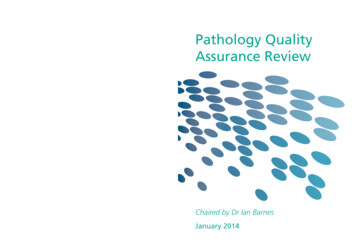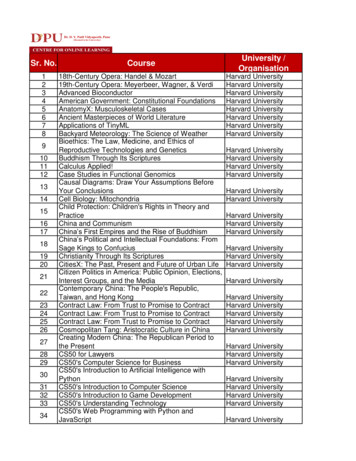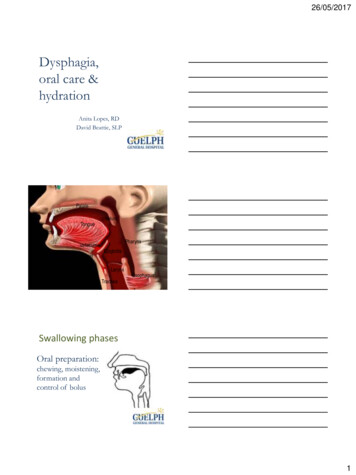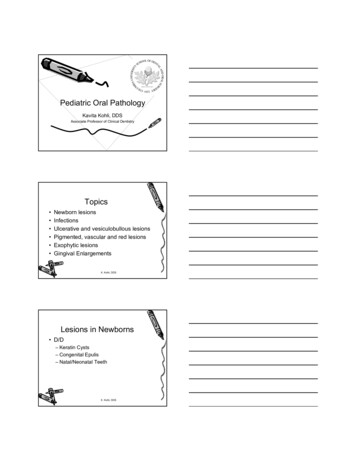
Transcription
Pediatric Oral PathologyKavita Kohli, DDSAssociate Professor of Clinical DentistryTopics Newborn lesionsInfectionsUlcerative and vesiculobullous lesionsPigmented, vascular and red lesionsExophytic lesionsGingival EnlargementsK. Kohli, DDSLesions in Newborns D/D– Keratin Cysts– Congenital Epulis– Natal/Neonatal TeethK. Kohli, DDS1
Keratin Cysts of theNewborn Epstein’s pearls Bohn’s nodules Dental Lamina cystK. Kohli, DDSEpstein’s Pearls Hard, raised smallnodules Arise from epithelialremnants trapped alonglines of fusion ofembryologicalprocesses. Appear in the midline ofthe hard palate, mainlyin the posterior section. Tx - no treatment.K. Kohli, DDSBohn’s Nodules Ectopic mucous glands. Small keratinizingcysts. Usually seen on thelabial aspects of themaxillary alveolarridges. Tx - no treatment.K. Kohli, DDS2
Dental Lamina Cyst Usually seen on the crest of thealveolus Remnants of the dental lamina. Tx - no treatment.K. Kohli, DDSCongenital Epulis of theNewborn Relatively rare, seen inneonates(at birth), ofunknown origin, withproliferation of mesenchymalcells. Equal distribution betweenmx and md. Females males. Usually firm,pedunculated,pink, smooth,solitary. Tx - often regress with time,but may need to be excised,recurrence is uncommon.K. Kohli, DDSNatal/Neonatal Teeth Natal - seen present at birth. Neonatal - seen within 30days of birth. In almost all cases it is theearly eruption of a primaryincisor. Usually only 5/6th of thecrown is formed and themobility arises from no rootdevelopment. Tx - nursing issues, firms upas root develops, may beextracted if aspiration apossibility.K. Kohli, DDS3
Oral Infections D/D – Bacterial– Viral– FungalK. Kohli, DDSBacterial Infections Odontogenic Scarlet feverTuberculosisAtypical mycobacterial infectionActinomycosisSyphillisImpetigo OsteomyelitisK. Kohli, DDSOdontogenic Infections Acute - sick child, raised temp., red swollenface. Chronic - sinus tract present, mobile and/ordiscolored tooth, halitosis. Tx – remove the cause and local drainage and debridement,– May admit if spikes in temp. seen, facial space involvementsuspected or seen &/or dehydrated.– Antibiotics - only if systemic involvement seen, or if child isimmunocompromised. Pen family first drug of choice.K. Kohli, DDS4
Osteomyelitis Some times an odontogenic infection canlead to osteomyelitis in the mandible. Radiographically - moth eaten appearance. Tx - curettage to remove bony sequestra,antibiotics (after culture and sensitivity test)for at least 6 weeks.K. Kohli, DDSViral Infections Primary herpetic gingivostomatitisHerpes labialisHerpanginaHand, foot and mouth diseaseInfectious mononucleosisVaricellaK. Kohli, DDSPrimary HerpeticGingivostomatitis Most common cause of severe oral ulcerations in children overthe age of 6 mos (peaks at 14 mos). Caused by Herpes Simplex Type 1. Incubation period of 3-5 days with a prodromal 48 hour h/oirritability, lymphadenopathy, pyrexia and malaise. Stomatitis seen, with gingival tissues become red andedematous. Vesicles seen any where on oral mucosa and rapidly breakdown to form very painful ulcers. Solitary ulcers ( 3mm) seenand some times larger ulcers with irregular margins are seenwhen there is coalescence of individual lesions. Self limiting and ulcers heal spontaneously without scarringwithin 10-14 days.K. Kohli, DDS5
Primary HerpeticStomatitis Exfoliative cytology, directimmuno-fluorescence, viralculture can be done to aiddiagnosis. Tx - symptomatic care,encourage hydration, painmanagement, chlorhexidinerinse or swabs on lesion,topical anesthetics , antiviraltherapy and may requirehospitalization.K. Kohli, DDSHerpangina and Hand,foot and mouth disease Caused by the Coxsackie grp Aviruses, usually seen in thesummer months in youngchildren.Prodromal phase that lasts forseveral days beforeappearance for vesicles(Herpangina - 4-5 vesicles,HFM - up to 10 vesicles).Commonly seen on palate,pillars of the fauces andpharynx and other sites (handand foot), malaise, fever.Milder than herpes , healing in10 days.Tx - symptomatic care.K. Kohli, DDSInfectious Mononucleosis Caused by EBV andusually seen in lateadolescents and youngadults. Highly infective. Malaise, fever andacute pharyngitis. In children, ulcers andpetechia often seen inthe posterior pharynxand soft palate. Tx - self limiting.K. Kohli, DDS6
Varicella Highly contagious virus. Seen as chicken pox inchildren and as shingles inadults. Prodromal phase of malaiseand fever for 24 hours,followed by crops of pruriticvesicles. 50% of children have orallesions. Tx - self limiting, resolves in7-10 days, supportive andpalliative.K. Kohli, DDSFungal Infections Candidiasis– Common oral organism, but usually does not causeinfection unless host is immunocompromised.– Acute pseudomembranous - in infants seen as Thrush.White scrapable plaques that reveal an erythematous base.In older children, seen in immunocompromised ones whoare under active treatment - like CT, RT, broad spectrumab.’s and steroids.– Median rhomboid glossitis - seen on dorsal surface of thetongue (usually anterior to the vallate papillae). Can be aresponse to broad spectrum ab.’s. Tx - antifungal for 4 weeks (Nystatin, AmphoB, Fluconazole or Ketoconazole.K. Kohli, DDSUlcerative andVesiculobullous Lesions D/D – Traumatic– Infective (already discussed)– OthersK. Kohli, DDS7
Traumatic lesions Self induced post-anesthetic trauma Riga-Fed e ulcerationK. Kohli, DDSSelf induced post-anesthetictrauma Most common cause oftraumatic ulcers. Usually seen in childrenwho have received theirfirst local anestheticinjection. Parents should bewarned and childrenmust be reminded notto bite their lips, cheeksetc.K. Kohli, DDSRiga Fed e ulceration Ulceration of the ventralsurface of the tongue ofan infant or child. Can be seen in childrenwith natal/neonatalteeth and those with CPor comatosed. Tx - smoothen sharpincisal edges or placedomes of compositeover the teeth, rarelymay need to extractteeth.K. Kohli, DDS8
Others Recurrent aphthous ulceration Erythema multiformeStevens-Johnson syndromeBehcets syndromeEpidermolysis bullosaLupus erythematosusNeutropenic ulcerationK. Kohli, DDSRecurrent aphthousulceration Estimated to affect up to 20% of the population. Seems to have a genetic predisposition, causeunknown 3 types Minor aphthae - majority of cases, crops of shallow ulcers upto 5mm, non-keratinized mucosa, typical yellowpseudomebranous slough with an erythematous border. Major aphthae - involves the kertinized mucosa, larger ulcers,last longer. Herpetiform ulcerationK. Kohli, DDSRecurrent aphthousulceration Tx - symptomatic care w/mouth rinses de, benadryl,xylocaine), heals within 1014 days without scarring forminor, but with scarring inmajor.K. Kohli, DDS9
Pigmented, Vascular andRed lesions D/D – Vascular– Pigmented– OthersK. Kohli, DDSVascular Lesions Hemangioma Other vascular malformations Hematoma Petechiae and purpura Hereditary haemorrhagic telangiectasia Sturge-Weber syndrome Maffuci’s syndromeK. Kohli, DDSHemangioma Endothelialhamartomas, Typically present atbirth, may grow with theinfant, but then regresswith time and may evencompletely disappear Tx - none requiredother than observation,may be a cosmeticconcern.K. Kohli, DDS10
Petechiae and Purpura Petechiae - small pinpoint submucosal orsubcutaneous hemorrhages. Purpura or ecchymoses present as largercollections of blood. Usually seen in patients with severe bleedingdisorders or coagulopathies, leukemia etc. Initially bright red in color, change to a bluishbrown hue with time as the extravasatedblood is metabolized.K. Kohli, DDSPigmented lesions Melanotic neuroectodermal tumor ofinfancy Peutz-Jeghers Syndrome Addision’s diseaseK. Kohli, DDSOther Red lesions Giant cell epulis/peripheral giant cell granuloma Eruption cyst Langerhans cell histiocytosis Geographic tongue Fissured tongue Median rhomboid glossitis - alreadydiscussed Heavy metal toxicityK. Kohli, DDS11
Eruption Cyst orhematoma Follicular enlargementappearing just beforethe eruption of tooth. Blue-black in color(may contain blood). Tx - none unlessinfected, reassure thechild and parent, folliclewill rupture, but mayneed to surgicallyopened if infected.K. Kohli, DDSGeographic tongue Also known as glossitismigrans, benign migratoryglossitis, erythema migransor wandering rash of thetongue. Areas of depapillation anderythema with a heaped upkeratinized margin on thelateral and dorsal surface ofthe tongue - map like areathat changes. Tx - none, may prescribechlorhexidine mouthwashand/or topical steroids whenchild in painK. Kohli, DDSFissured Tongue Also known as plicatedtongue, scrotal tongue,fissured tongue or linguasecta. Usually see fissures that runperpendicular to the lateralborders Commonly seen in childrenw/ Downs. About 20% will also havegeographic tongue orassociated c/ MelkerssonRosenthal Syndrome. Tx - noneK. Kohli, DDS12
Exophytic Lesions D/D – Inflammatory– Congenital epulis of newborn– Squamous papilloma– Viral Warts– Eruption cysts/hemtomasK. Kohli, DDSInflammatory Hyperplasias Fibrous Epulis Giant cell epulis/peripheral giant cellgranulomaK. Kohli, DDSFibrous Epulis Most common exophyticlesion, also called fibromaand pyogenic granuloma ifinfected. Usually an unusualresponse to plaque. Commonly seen oninterdental papillae, usuallypink (red -yellow). Can be firm or soft Tx - improvement of oralhygiene, removal of irritant,surgical excision, canreoccur.K. Kohli, DDS13
Giant Cell epulis/peripheralgiant cell granuloma Occur in the primarydentition, wellcircumscribed, sessilenoduleous nodule, oftenulcerated and hemorrhagic. Color usually dark purple “liver colored”, alveolar boneloss seen as cupping in theradiograph. D/d - central giant cell if intraosseous lesions. Tx -surgical excision, watchfor recurrence.K. Kohli, DDSSquamous papilloma True benign tumor. Cauliflower-like growthon the mucosa. Color depends ondegree ofkeratinization. Clinically hard todistinguish from a viralwart. Tx - surgical excision,including the stalk andnormal border tissue.K. Kohli, DDSViral Warts Viral infection of thehuman papilloma virus. May be multiple orsingle. Look for warts on otherareas of the body,especially hands andfingers. Surgical excision, extraoral lesions may needto be managed by adermatologist.K. Kohli, DDS14
Gingival Enlargements D/D – Drug induced hyperplasias– SyndromesK. Kohli, DDSDrug Induced Hyperplasia PhenytoinCyclosporin ANifedipineverapamilK. Kohli, DDSDrug Induced GingivalEnlargements Phenytoin Interdental papillae, may be delayed eruption due the bulk offibrous tissue, ectopic eruption, withdrawal of drug will bringabout resolution in most cases. Tx - oral hygiene key in control of overgrowth, chlorhexidinemouthwash, gingivectomy to allow for eruption and esthetics. Cyclosporin A H/o liver, kidney, heart and combined heart/lung transplants.most commonly used med for anti-rejection, seen in about 3070% of these cases. Nifedipine and verapamil Both are calcium channel blockers, used to control cyclosporininduced hypertension after transplants in children. Tx - oral hygiene and gingivectomy.K. Kohli, DDS15
Syndromes with gingivalenlargement Hereditary gingivalfibromatosis– May be associated withintellectual disabilities– May be sporadic inoccurrence or an AD orAR trait.– Tx - gingivectomy orperio flaps to allow foreruption, maintainesthetics Others e.g.: Leukemia.K. Kohli, DDSReferences Handbook of Pediatric Dentistry, 2nded. by Cameron and Widmer. Dentistry for the Adolescent and child,7th ed. by McDonald and Avery. Oral and Maxillofacial Pathology byNeville, Damn, Allen and Bouquot. The Handbook, 2nd ed., AAPD.K. Kohli, DDS16
Handbook of Pediatric Dentistry, 2nd ed. by Cameron and Widmer. Dentistry for the Adolescent and child, 7th ed. by McDonald and Avery. Oral and Maxillofacial Pathology by Neville, Damn, Allen and
